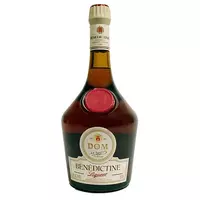Benedictine

Since its inception, liqueurs have managed to gain such great popularity that today it is impossible to imagine almost any event without them. Their distinctive feature is hidden in a soft sweet taste. In addition, liqueurs are less unhealthy than most other alcoholic beverages. On the contrary, in moderate numbers, they contribute to the normalization of the body, increase immunity and improve overall tone.
Considering the varieties of liqueurs, you can distinguish a whole galaxy of the most interesting proposals. Among them is the so-called Benedictine liqueur. This strong French alcoholic drink is made on the basis of alcohol and sugar beet. In addition, it contains honey and some herbs. The basic strength of the beverage is 40%.
The history of the appearance of liquor goes back to the distant 16th century, namely in 1510. Its founder is the monk Don Bernardo Winzelli from the monastery of St. Benedict. The label of each bottle should contain the initials D. O. M. , which means "Deo Optimo Maximo. " Translated from Latin, this means: "Lord, Best, Greatest. " The recipe for the drink was lost during the French Revolution, but was restored in the 19th century through the efforts of the Norman wine merchant Alexander Legrand.
Drinking Benedictine liqueur
The alcoholic beverage contains about 27 herbs and infusions. It undergoes long-term treatment in 4 different maceration and distillation steps. Natural or cognac alcohol is used as a base. Hold for 17 months before pouring into the bottle. This is exactly what gives Benedictine liquor a fortress in the amount of 40%.
The drink can be consumed solo, but it manifests itself best in a composition with other elements in cocktails. If you want to feel the fullness of the taste of the liqueur, then mix it with gin, grenadine, dry vermouth or orange liquor. With these same elements, you can create cocktails such as mar del plata, booz fiz, Mexican breakfast and champion. The skillful bartender will be able to offer more than 10 drinks that differ in their recipe, as well as in taste and color.
Contraindications to the use of liquor
The drink is usually contraindicated in diabetics. Also, its use should be excluded for people with diseases of the stomach or cardiovascular system.
Benedictine kCal
The energy value of benedictine (Ratio of proteins, fats, carbohydrates - ju):
Proteins: g (~ 0 kCal)
Fats: g (~ 0 kCal)
Carbohydrates: g (~ 0 kCal)
 Español
Español Français
Français Português
Português Русский
Русский 简体中文
简体中文 繁體中文
繁體中文 日本語
日本語 한국어
한국어 العربية
العربية Türkçe
Türkçe Қазақ
Қазақ Deutsch
Deutsch Italiano
Italiano Українська
Українська
